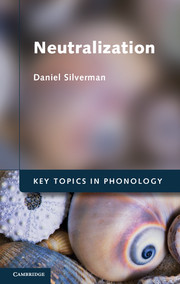Book contents
- Frontmatter
- Contents
- List of Figures
- Preface
- Acknowledgments
- 1 The rhyme and the reason of neutralization
- Part I Rhyme
- Section A Observation and description
- Section B False positives
- Section C Explanation
- 7 Ease of production
- 8 Ease of perception
- 9 Phonetic misperception
- 10 Semantic misperception: early proposals
- 11 Semantic misperception: recent proposals
- Section D Exemplification
- Part II Reason
- Glossary
- References
- Language index
- Subject index
11 - Semantic misperception: recent proposals
Published online by Cambridge University Press: 05 November 2012
- Frontmatter
- Contents
- List of Figures
- Preface
- Acknowledgments
- 1 The rhyme and the reason of neutralization
- Part I Rhyme
- Section A Observation and description
- Section B False positives
- Section C Explanation
- 7 Ease of production
- 8 Ease of perception
- 9 Phonetic misperception
- 10 Semantic misperception: early proposals
- 11 Semantic misperception: recent proposals
- Section D Exemplification
- Part II Reason
- Glossary
- References
- Language index
- Subject index
Summary
For the bulk of his 1994 book, Labov employs a rather particular working definition of the term “functionalism”. For Labov, the “functionalist hypothesis” is primarily syntagmatic in orientation, where “syntagmatic”, for Labov, refers to “the stream of speech . . . where the speaker has the opportunity to adjust the choice of variants at one point to compensate for the presence or loss of information at other points” (p. 570). In other words, in this narrow sense, “functionalism” refers to a synchronic “on-line” or “on the fly” monitoring of the semantic content of the speech signal such that this code is constantly being updated to ensure a lack of semantic ambiguity for the listener. As documented in Chapter 19 of his book, Labov's findings regarding functional pressures on language use (in this sense) are largely negative. Instead, “speakers are more influenced by the tendency toward structural parallelism” (p. 570). For example, in any given utterance, if one agreement marker is present in a construction, all tend to be present, but if one is dropped, all tend to be dropped; clearly not a “functional” result, since in the former case, the structure may possess unnecessary redundancy, and in the latter case, the structure is devoid of agreement markers.
However, by expanding the scope of “functionalism” to incorporate the paradigmatic structural properties of language – where, for Labov, “paradigmatic” properties include the slow, diachronic, and decidedly passive accumulation of structural changes to the system as a whole, such that the speech code naturally settles towards a semantically unambiguous state – he changes his tune considerably regarding the efficacy of functionalism. Here, in his Chapter 20, he indeed finds striking positive evidence for functional influences on the structure of the linguistic system, among them, a gravitational tug towards lexical semantic clarity as embodied in a passive pressure towards homophone avoidance.
- Type
- Chapter
- Information
- Neutralization , pp. 119 - 129Publisher: Cambridge University PressPrint publication year: 2012

